Monterrey Tec Library and Pavilion Open

 Sasaki
Sasaki

“We wanted it to feel like a treehouse in the middle of the campus forest. We thought of the building as a cloud hovering over a major plaza ,” says Pablo Savid, Sasaki principal in charge for the Monterrey Tec’s new library at its grand opening last month. With its transparent façade mirroring the sky and its cantilevered body, the building seemingly does float right off the ground and into the canopy of mature trees surrounding this central site on Monterrey Tec’s (the Tec’s) main campus.
Hundreds of people streamed by Savid in the sun-soaked courtyard of the new library’s central atrium. They zipped around him and up the building courtyard’s Escher-esque staircases, leading right up to the slice of sky above. It’s the kind of design that can only exist in the warm and hospitable climate of the city of Monterrey, which is home to 1.1 million people.

On rainy days people stick to interior routes. But on this day, there was nothing but warm rays streaming down as the building welcomed an unprecedented number of visitors. Students, administrators, trustees, donors, locals, and the many teams who worked on the building’s design and construction came to see the new building in action. They had watched its construction over the last 18 months, rapid by any measure, and this moment was a milestone occasion to celebrate. Already, administrators and project team members speculated that more chairs would need to be ordered, the open seating spaces were so overwhelmingly popular. This was music to Savid’s ears.

For three years Savid [pictured above, right] co-led a multidisciplinary team with fellow principals Bryan Irwin, AIA and Lan Ying Ip, AIA to realize this building and a nearby pavilion, la Carreta, as cornerstones of the campus and urban district master plan. The buildings are central to a larger strategic framework plan for the university led by Sasaki Urban Designer and principal Dennis Pieprz, Hon. ASLA [pictured above, left], that included Tec 21, a new vision for learning and learning environments.
The opening of these two buildings heralds a new era for the school. They support the long-term implementation of a forward-looking strategic reorientation of The Tec’s pedagogical model for its 31 campuses across the country. The Tec’s ambitious commitment to shaking up its educational model pre-dated the current economic climate in Mexico, but its success is all the more important as an investment in the next generation. Administrators and educators at the Tec evaluated the needs of the country, the demands imposed on its emerging workforce, and the changing nature of the global economy and then put the wheels in motion to adjust the institution’s curriculum and academic offer accordingly.
As they looked at the challenges on the horizon facing young people—innovating new energy sources, mitigating climate change effects, navigating global connectedness and competition—they saw how the next generation of young Mexicans will need to be prepared to nimbly cross disciplines and solve problems. Their bet is that the traditional concentration or major is not going to be enough. Instead, the next generation of Tec students will be immersed in a series of months-long “Challenges” to solve real-world problems with students, professors, and industry collaborators, giving them hands-on team problem-solving skills that will feed directly into their careers post-graduation.
The library and la Carreta, within this context, serve as crucial crossroads for students who need places to team up and exchange knowledge, information and experiences. The centuries-old traditional suite of learning environments ubiquitous to campuses around the world needed redesigning from the ground up. The administration started with a plan and invested in testing out spaces to support the new curriculum.
The Tec is one of the first master-planned university campuses in Mexico. And the strength of its plan shows, as the library was already sited in the perfect location within the campus’ historic core. In fact, the new library replaces a library that had stood there for decades. While the design team explored renovation, in the end, that original structure could not bear the weight of new additions and they set out to create a new design that Savid describes as “turning the old library inside out.” The new design would fight against the idea that the library needed to be a bunker for quiet and solo study and the storage of books.

On approach the building blends with the surrounding campus architecture which is classically modern in style. But it differs in its distinct transparency, featuring floor to ceiling glazing that is only interrupted by the building’s vertical louvers, and the imprint of the library’s diagonal bracing structure that weaves around the entire building’s facade. The glazed six-story building is also taller than its neighbors, commanding views of the surrounding landscape and making itself a visible beacon at the heart of campus.
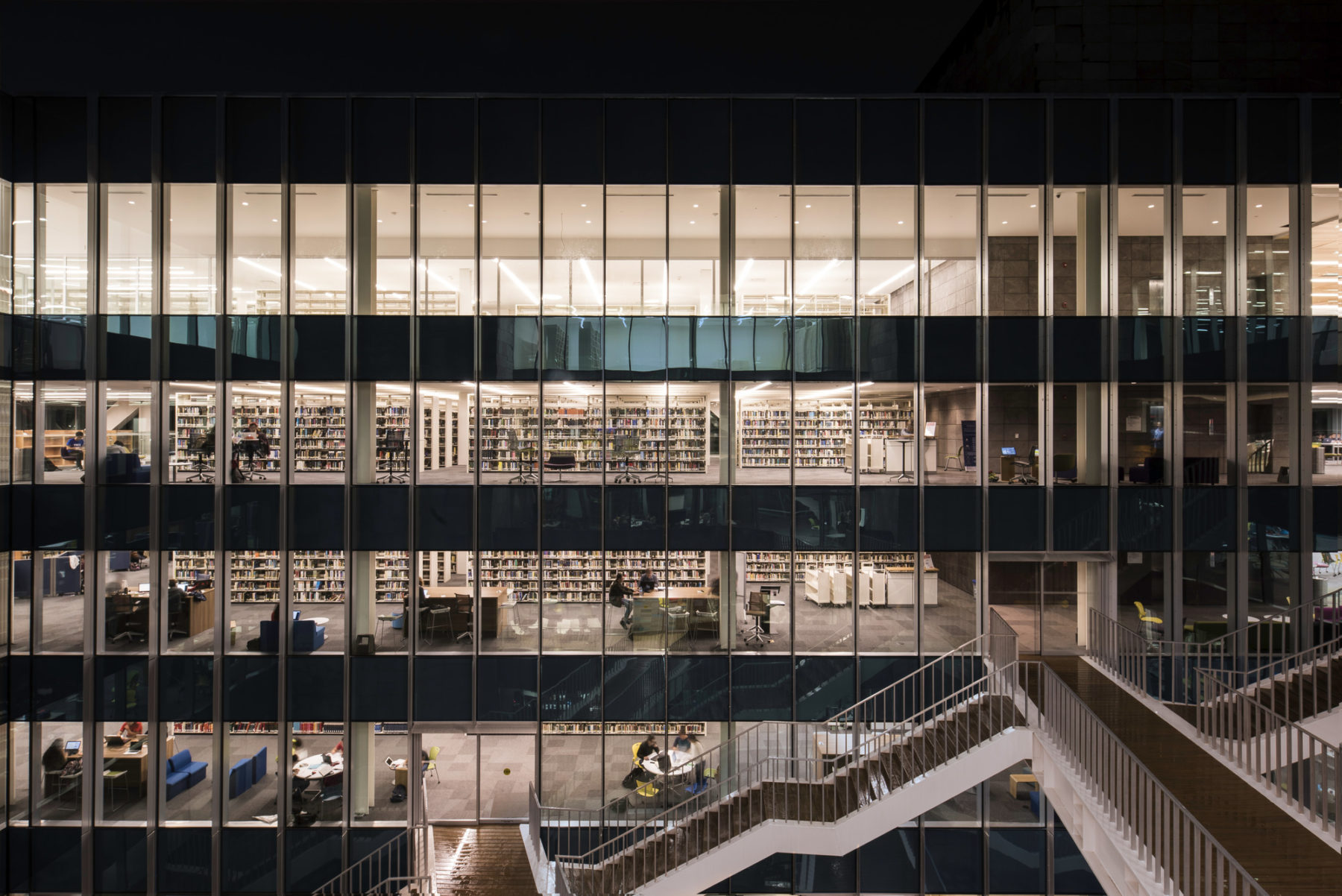
From its ground-floor welcome to its rooftop, various forms of group study and social gathering places figured prominently into the program. The ground level carries forth the most successful feature of the former library, its front gallery and large outdoor welcome space. The new building further expands that frontage space, transforming it into a covered plaza animated by an amphitheater, maker space and meeting spaces, the university’s bookstore, and a café. The main library program begins on the next floor up, with the ground floor functioning as an enticing social space to draw people in.

To preserve ultimate flexibility, the team found creative ways to create an open floor plan layout and minimize columns throughout. They employed a series of vertical cores connected by belt trusses in the building perimeter to “hung” the building’s floor plates and free the spaces of columns at critical areas, with its most dramatic cantilever reaching 60’ in length. The design also features double-height spaces with alternating mezzanines to create long, diagonal views that cut across the large rectangular footprint. As a result, a constant flow of people on display activates the space, adding dynamism and movement to the layout.
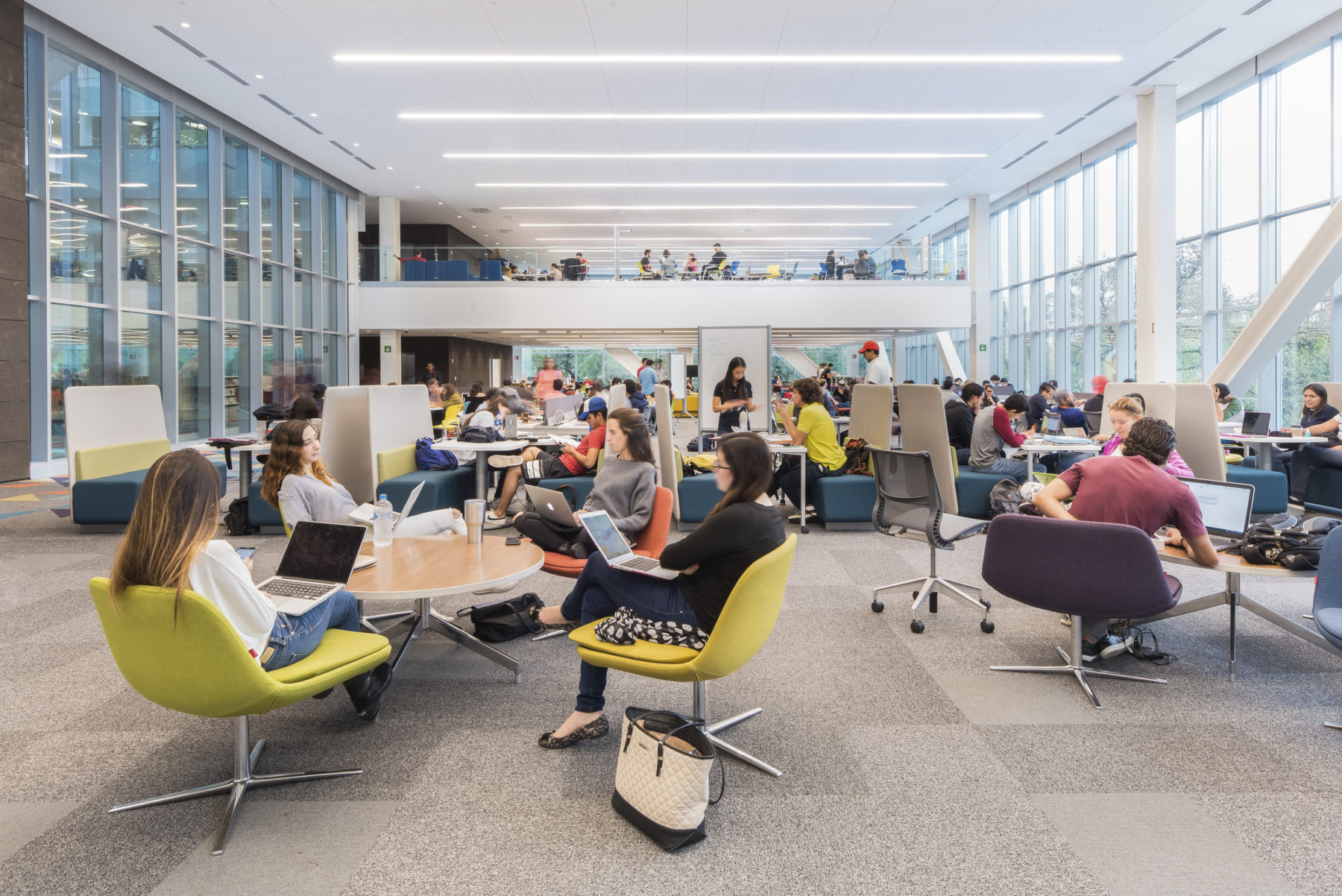
One such double height space is populated by what the design team calls “book boxes.” These study rooms allow people to enter into a smaller quiet space. Above the boxes are lounges for more relaxed gatherings. And on all sides the boxes are lined in books so the collection is always on accessible display.

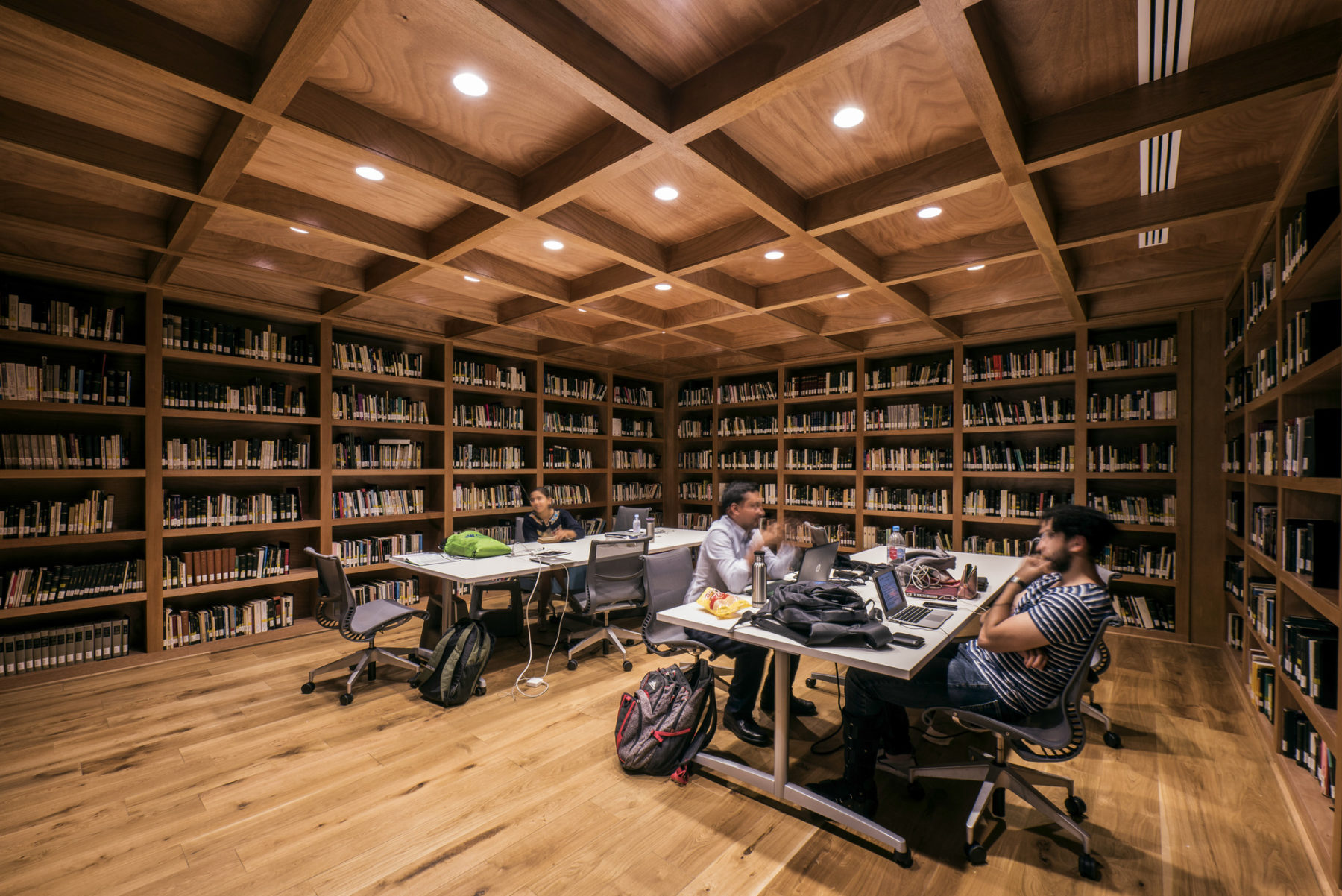
The discovery sequence around the library culminates at the uppermost corner of the building facing the Jardin de Las carreras, in the form of a terrace with a framed view of a city-scape vista against a majestic mountain range in the background. The views from this open-air, covered terrace, are so enticing that global vendors have vied for that remote space, knowing that students will make the trek for the magnificent setting—and the caffeine. This overlook, which was an essential part of the design in its early days, offers the visitor multiple visual connections: a unique rendition of the campus garden and its buildings in the historic core, ample views of the new campus districts to come and Monterrey’s most iconic vista with the Cerro de la Silla in its backdrop.
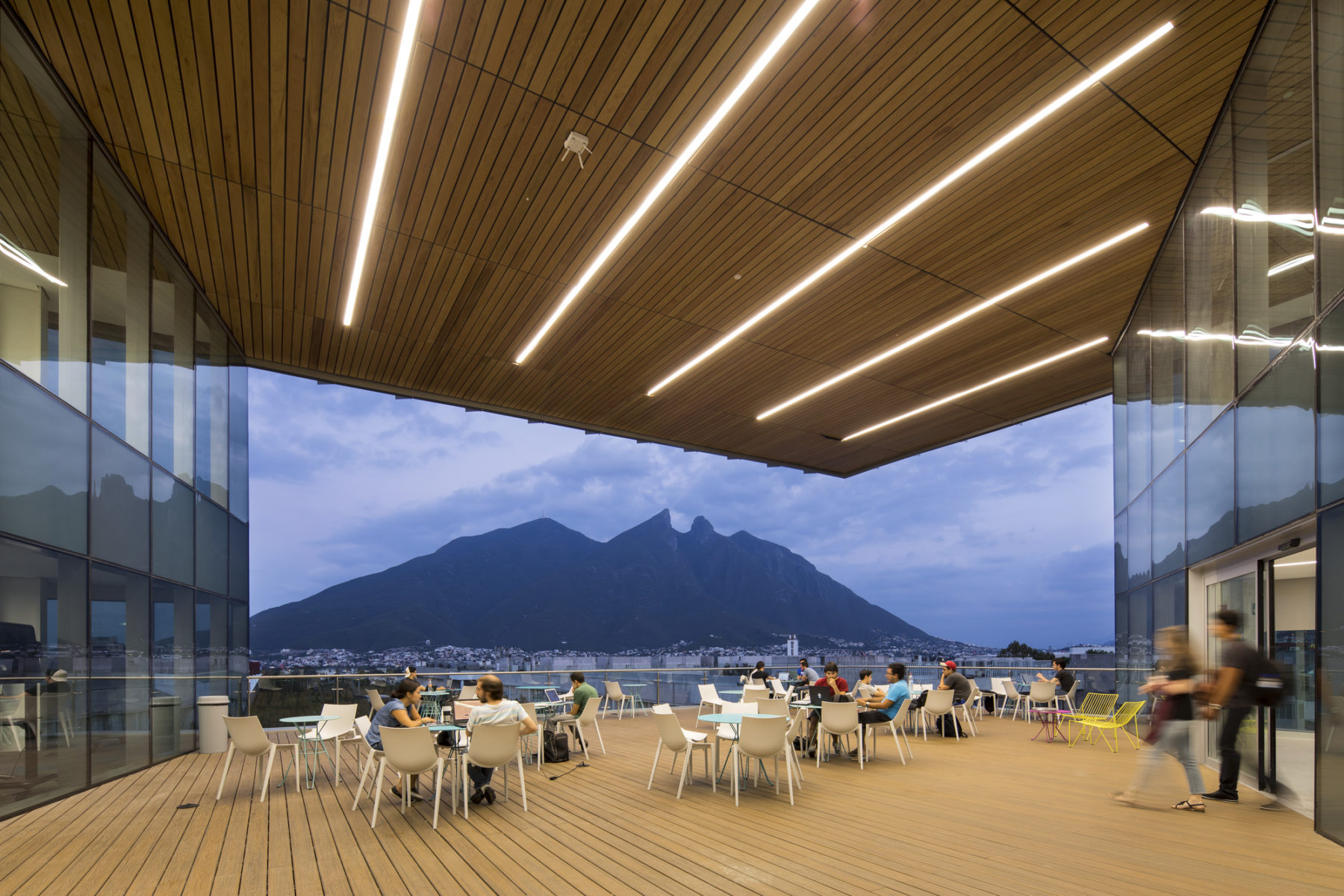
Located at the heart of the campus historic core, the Carreta pavilion is a multi-purpose building designed to host a wide range of functions: TED talks, student forums and debates, academic conferences and lectures, thesis exhibits, art installations, technology fairs, social events, banquets and receptions, and when not formally programmed, meeting, informal group study and dining, and a place for student group activities, including yoga classes.
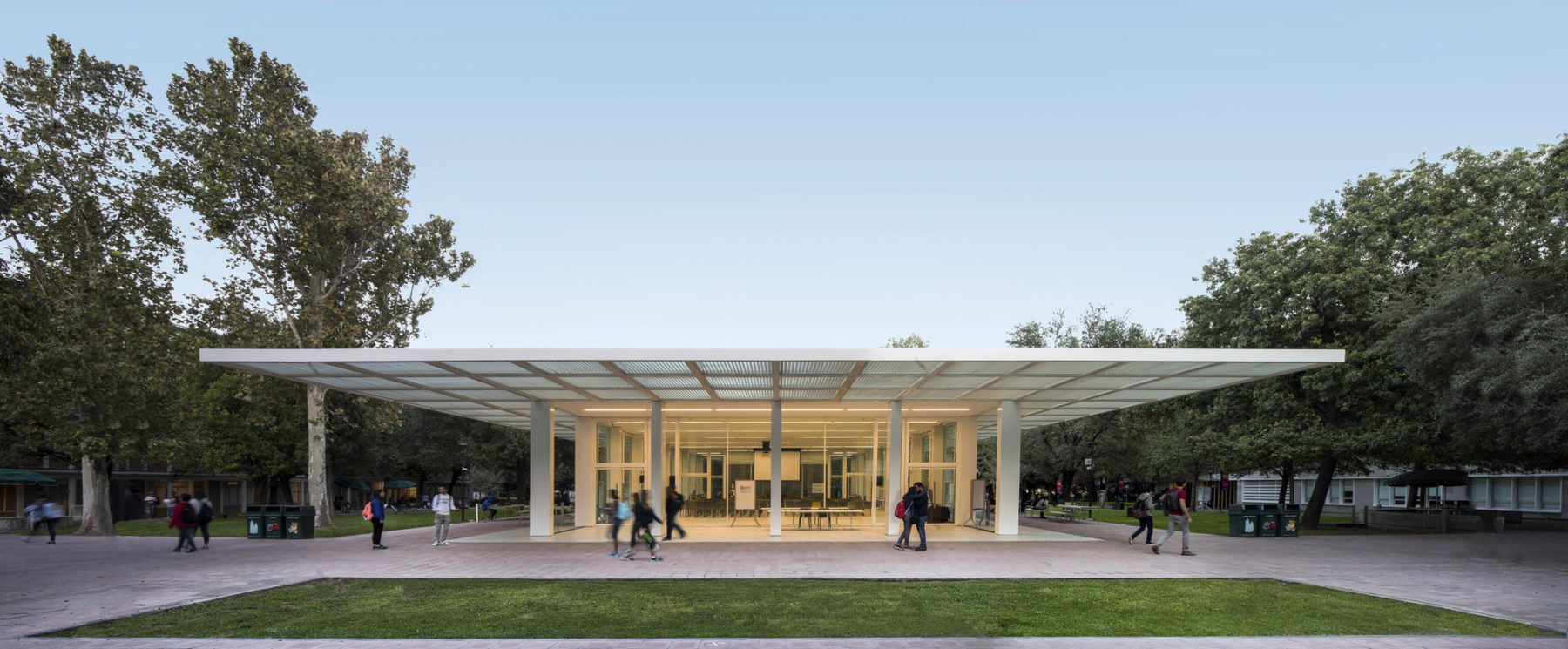
One of the main functions the pavilion will serve within the context of the Tec 21 pedagogical shift toward a “Challenge-oriented” curriculum is to ensure people know about the many things going on around campus. There will be perpetual research, invention, competition, and collaboration happening at all times on campus, and this pavilion—and hopefully others like it when they are built—will become critical display and presentation space for teams. For this reason, the administration looks to la Carreta as a symbol of the Tec 21 campus of the future. “It brings people together from different threads to create exchange points. The idea of la Carreta became deeply tied to the philosophy and theory of teaching,” explains Pieprz.

La Carreta was to be programmatically rich while being architecturally neutral, subtle, and intentionally spare in its design as an inhabitable pavilion in the middle of the campus garden. The animation given to the pavilion by its users and their activities is what gives the building its ultimate color and character.
The space can congregate up to 200 people in a lecture setting, be completely open for large 600-person events, or be partitioned into twenty-person rooms for more intimate gatherings. “Flexibility and integration was everything when it came to design. The pavilion is a container that can transform itself depending on the use” adds Savid. “People say to us that it’s like it has always been there. That’s when we knew we had done it right. The building and the landscape have such strong cohesion that is immediately recognizable to those seeing it for the first time”.
The pavilion’s structural grid lines are derived from the modulation of the surrounding campus core buildings and their structures. The enclosure of the pavilion is defined by 15’ tall glass pivot doors surrounding a long, single story floor plane. The pavilion has columns embedded in the glazing enclosure and benefits from a large surrounding pergola that tames Monterrey’s direct sun impact and filters daylighting all around it. With the ability to open entirely to its surroundings, the structure transforms into an open-air shelter in the heart of the campus.
The pavilion was largely fabricated offsite at a product manufacturing shop and assembled on site as a kit of parts. The hardware of the pavilion and its building systems are totally integrated with the design of the building’s enclosure and structure. The superstructure of the pavilion rests over a conventionally-built foundation and basement space that anchors its metallic frame and houses all utility and systems connections and provides ample storage for the pavilion’s diverse furniture and partition sets. This intentional approach to its design and construction allows the pavilion to function as a prototype that can be replicated on other campuses.

Both the library and la Carreta signal a whole culture-change for the Monterrey Tec university system. Throughout Mexico and many other Latin American countries, privacy has been a carefully guarded ideal. Gated residential communities and walled-in campuses are commonplace. At the Tec, however, a different energy permeates: a new philosophy of openness is taking root that extends far beyond rhetoric and into the very tangible experiences of a new pedagogy and the porous spaces that support it.
With doors wide open, the Tec’s newest architectural additions to campus are poised to energize and serve the community as a new amenity. But, as with any great design, the team hopes these new buildings will soon settle into the landscape as fixtures within the Tec community that feel as though they have been there all along. As the opening-day festivities wind down, Pieprz turns to Savid to say, “one day, I want students to take what is radical today for granted.” Savid glances at the many students sprawled across the furniture and queuing in line for coffee and it seems to him that that day is not too far off.